Nowruz, Persian New Year: Meaning, History, Celebration
Nowruz, also spelled as “Norooz” or “Nawruz,” is actually the Persian New Year, celebrated by millions of people worldwide. The holiday usually falls on or around March 20th or 21st, coinciding with the arrival of spring, and it represents a time of renewal and fresh beginnings.
The word “Nowruz” itself means “New Day” in Persian, and this festival is deeply rooted in the culture and traditions of Iran, with its origins dating back more than 3,000 years. While Iran is the center of Nowruz celebrations, the festivities have spread to various countries with Persian influence and Iranian diaspora communities globally.
It is a time of joy when families come together, homes are cleaned and decorated, and symbolic rituals are performed to welcome the New Year. Now, let’s delve deeper into the magic of Nowruz and discover the customs, traditions, and the significance of this vibrant celebration.
What Is Nowruz?
Nowruz is an important celebration in Iran and several other countries. It marks the beginning of the new year and coincides with the arrival of spring.
Nowruz is a long-standing tradition rooted in Iranian culture and history. It is officially recognized as a holiday in various nations, including Afghanistan, Tajikistan, Russia, Turkmenistan, India, Pakistan, Kyrgyzstan, Syria, Iraq, Georgia, Azerbaijan, Albania, China, and Uzbekistan.
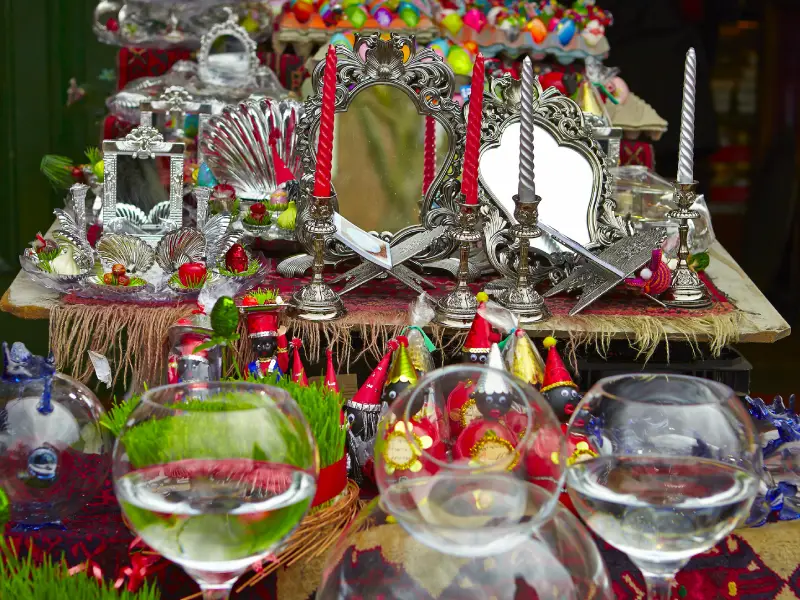
The essence of Nowruz lies in the idea of renewal and rebirth, mirroring the rejuvenation of nature as winter gives way to spring. People celebrate by performing various customs and traditions, including cleaning and decorating their homes, visiting friends and family, wearing new clothes, and preparing traditional dishes.
Nowruz begins with the vernal equinox, symbolizing the moment when day and night are of equal length, emphasizing the balance in the universe. According to the solar calendar, this equinox marks the transition to the new year, which falls on the first day of the month of Farvardin.
Nowruz Festival History
The history of the Nowruz festival can be traced back to different periods in Iranian history, including the times of the Achaemenids and the Sassanians.
During the Sassanian era, the New Year celebration was particularly significant. It was divided into two parts: Nowruz Kuchak (Small Nowruz) and Nowruz Bozorg (Grand Nowruz). Nowruz Kuchak, also known as Nowruz Ameh, spanned for five days, from the first to the fifth day of Farvardin, the first month of the Persian calendar.
The sixth day, known as Khordad-Rooz (Day of Khordad), was celebrated as Nowruz Bozorg or Nowruz Khaseh (Special Nowruz).
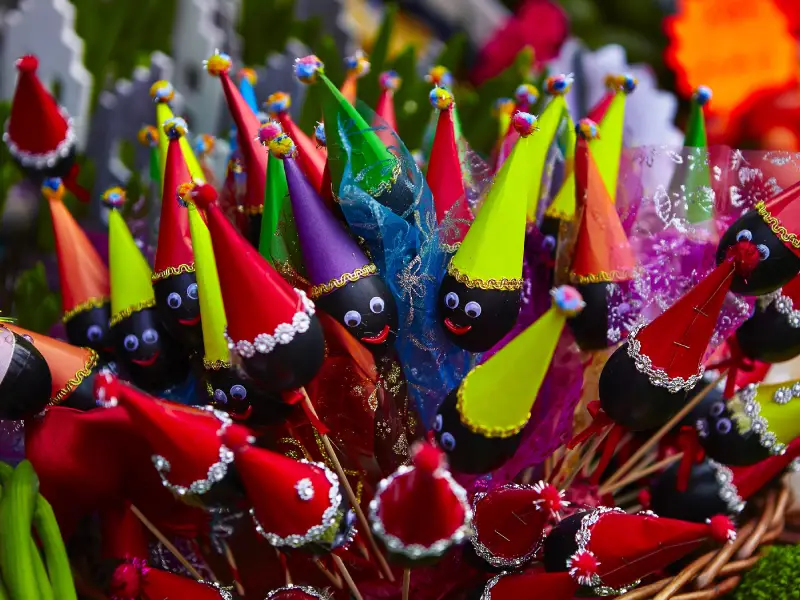
Each day of the festival was marked by special rituals and customs. People would visit the royal court to meet the king, who would listen to their concerns and issue commands to resolve their issues.
On the sixth day, only those close to the king were granted an audience. The importance of Nowruz was more than a mere celebration; it served as a time for communication between the people and their ruler and strengthened a sense of unity and cooperation within the society.
Nowruz Meaning
The word “Nowruz” has its origins in the Middle Persian language, specifically from the term “nōgrōz,” which in turn traces its roots to the Avestan language. Historians have speculated that the Avestan equivalent might have been “navaka raocah.”
In contemporary Persian, the term “Nowruz” carries two distinct meanings:
- Nowruz Ameh: This refers to the day of the vernal equinox, marking the beginning of spring and the start of the new year.
- Nowruz Khaseh: This signifies the sixth day of the Persian month of Farvardin, known as “Ruz-e Khordad,” which is celebrated as a special day.
Ancient Iranians referred to Nowruz as “Nawasarda,” meaning the “New Year.” During different periods, such as the Sogdian and Khwarezmian eras in Central Asia, Nowruz was referred to as “Nawruz” or “Nawsardji,” signifying the New Year.
How Is Nowruz Celebrated?
Nowruz, the Persian New Year, is celebrated with an array of customs and traditions that last for several days. The festivities begin with thorough spring cleaning, symbolizing the removal of negativity and the preparation for a fresh start.
Families come together to decorate their homes and set up the Haft-Seen table, an essential centerpiece adorned with seven symbolic items, all starting with the Persian letter “S.”
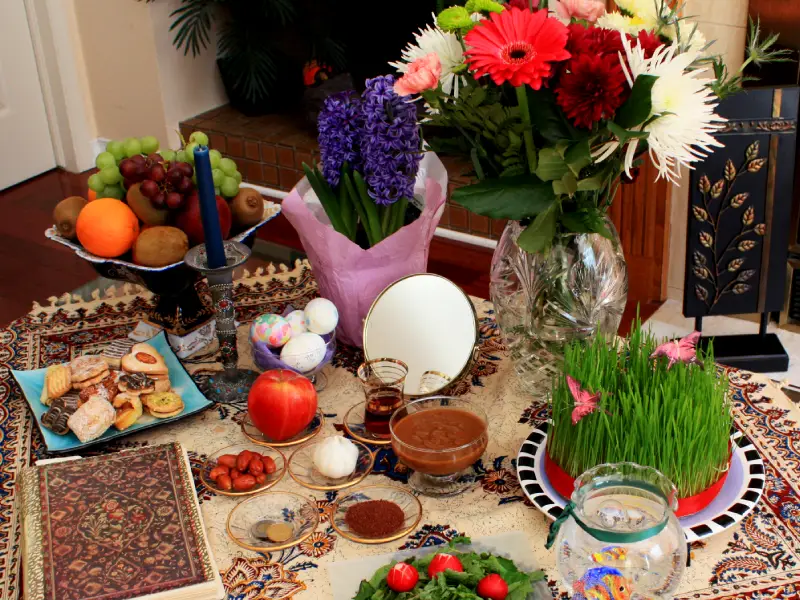
These items carry deep meaning and include sprouted wheat, sweet pudding, dried oleaster fruit, garlic cloves, apples, sumac berries, and vinegar.
People dress in new clothes and visit friends and family, exchanging gifts as a symbol of blessings and good wishes. Jumping over bonfires during Chaharshanbe Suri, the fire-jumping ritual, is a lively start to Nowruz, where participants cast away misfortunes.
On the day of Nowruz itself, the vernal equinox, families gather for a special meal, often serving traditional dishes. Music, dance, and cultural exhibitions further enrich the celebrations, creating a vibrant atmosphere of joy and unity.
Which Religion Celebrates Nowruz?
Nowruz is mainly celebrated by people of Zoroastrian, Baha’i, and Muslims, especially among Shia Muslims. However, it is important to note that Nowruz has transcended its religious origins and is now celebrated by different communities and people from various religious and cultural backgrounds.
It has become a secular celebration of the arrival of spring and the start of the new year in many parts of the world, and people of different religions often join in the festivities.
Thus, while it has strong historical ties to Zoroastrianism, Nowruz is a celebration that has evolved to embrace a wide range of cultural and religious perspectives.
Nowruz Haft-Seen Table
The Nowruz Haft Seen (or Haft Sin) table is a special and symbolic centerpiece of the Nowruz celebration. It is traditionally decorated with seven items that begin with the Persian letter “S,” hence its name, Haft-Seen. These items hold deep symbolic meaning, representing various aspects of life and renewal.
Some of the symbolic items include “seer” for garlic, which symbolizes medicine and good health, “sekke” for coins, which symbolizes prosperity, “samanu” for sweet pudding, which symbolizes power and strength, “sabzeh” for sprouted wheat or barley, symbolizes rebirth and growth, and the “Quran” for wisdom and spirituality.
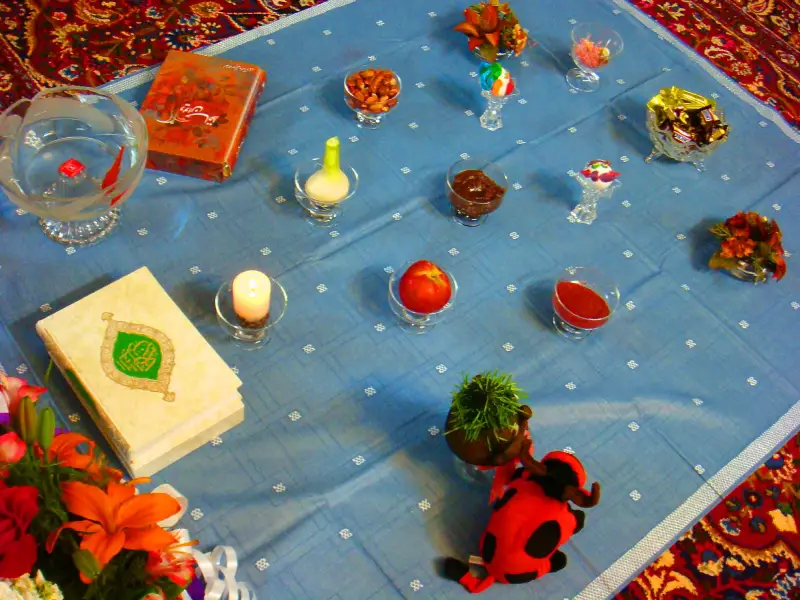
Additionally, the Haft-Seen table includes other elements with both symbolic and hospitality aspects. These may include various types of nuts and sweets, mirrors, candles, and a bowl of water with goldfish.
The Haft-Seen table is a reflection of the rich cultural and spiritual heritage of Nowruz, and its preparation is an essential part of the festive traditions.
In the past, people used to cook a special dish called “polo” on the night of Nowruz, which was shared with the less fortunate, neighbors, and religious leaders as an act of generosity and goodwill.
The Haft-Seen table is not only a beautiful centerpiece but also a powerful symbol of hope, renewal, and the unity of families during Nowruz.
The Seven Items of the Haft-Seen Table
The Haft-Seen table features seven symbolic items, each carrying its own profound meaning. These items serve as a reminder of important aspects of life and renewal:
- Sabzeh: Sabzeh is sprouted wheat, barley, or lentils and symbolizes rebirth and the renewal of nature as the new year begins.
- Samanu: Samanu is a sweet pudding made from germinated wheat, representing the sweetness and joy in life’s moments.
- Seeb: The red apple signifies beauty and the blossoming of life, much like the vibrant colors of spring.
- Senjed: Senjed is a sweet, dried oleaster fruit similar in size to a white mulberry. It represents love and compassion.
- Seer: Garlic cloves, known as “seer,” are a symbol of good health and well-being.
- Somāq: Sumac berries, a popular Iranian spice, symbolize the sunrise, the victory of light over darkness, and patience.
- Serkeh: Serkeh, or vinegar, represents wisdom, maturity, and the ability to endure life’s challenges with patience.
Facts about Nowruz
One interesting Nowruz fact is its global recognition by the United Nations. On March 21st, which coincides with the first day of Farvardin, the UN General Assembly adopted a resolution designating March 21st as the “International Day of Nowruz” within the framework of the culture of peace.
This historic decision marked the first time the UN formally acknowledged Nowruz as an international occasion.
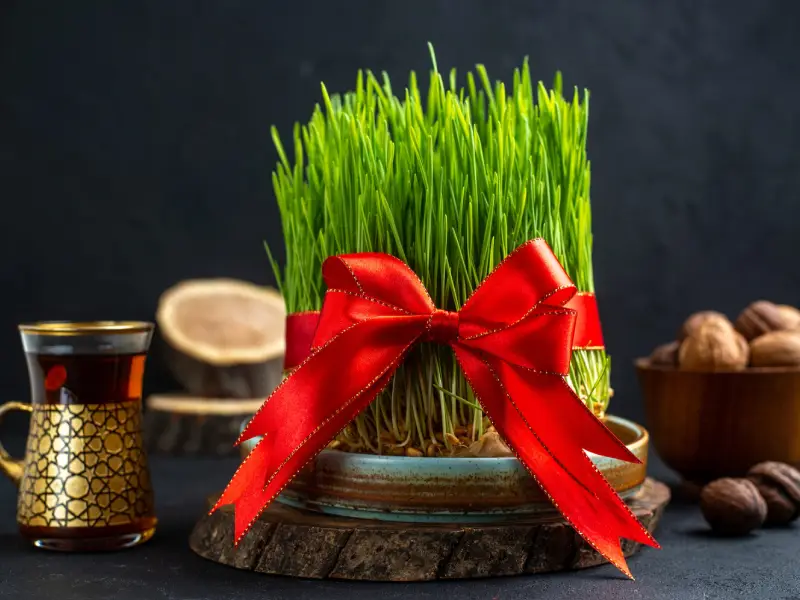
In recent decades, Iranian communities outside of Iran, especially in Europe, the Americas, and Canada, have been hosting group celebrations of Nowruz, including the lively Chaharshanbe Suri, marking the eve of Nowruz with bonfire jumping and festive activities.
In Iran, the celebration of Nowruz is not just a day but extends to a 13-day official holiday. The first four days of Farvardin, which coincide with the start of Nowruz, are designated as official holidays.
Schools remain closed during this period, allowing families to come together, visit loved ones, and engage in various customs and festivities.
Final Word
Nowruz is a magnificent celebration that brings people from all walks of life together to celebrate the arrival of spring and the promise of a new beginning.
This ancient tradition, rooted in Iran but celebrated around the world, shows the enduring power of culture, unity, and hope. As families gather around the Haft-Seen table, as children leap over Chaharshanbe Suri fires, and as communities come alive with music, dance, and joy, Nowruz reminds us of the beauty in diversity and the importance of cherishing our heritage.
So remember that this celebration is not just about a new year; it is about the timeless bonds that connect us all in our shared journey through life.
Are you planning to travel to Iran and looking for an Iran resort? Consider Matinabad eco resort.

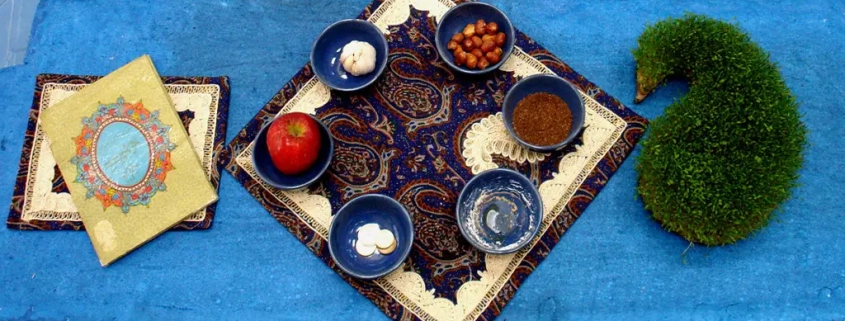



Leave a Reply
Want to join the discussion?Feel free to contribute!